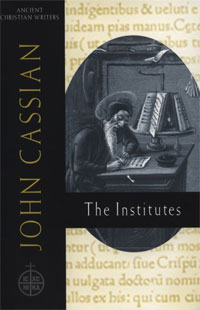Book Notes
 John Cassian, The Institutes, translated and annotated by Boniface Ramsey (New York: The Newman Press, 2000), 287pp.
John Cassian, The Institutes, translated and annotated by Boniface Ramsey (New York: The Newman Press, 2000), 287pp.
Like many early Christian writers, the life of John Cassian (c. 360–c. 435) remains shrouded in the mists of forgotten history. He was probably born in present day Romania (Dacia). When he was about twenty he traveled with his friend Germanus to Bethlehem where he joined a monastery. From Bethlehem Cassian and Germanus made at least two extended visits to the famous monastics down in Egypt (by some estimates they spent ten years there), and from there moved on to Constantinople. In Constantinople the bishop John Chrysostom ordained Cassian to the diaconate some time around the year 400, at which time he traveled to Rome to courier some letters and was ordained a priest by Pope Innocent I. Cassian later settled in Marseilles, where he founded two monasteries, and wrote three books. His Institutes, along with its much longer companion volume entitled Conferences (some 700 pages), chronicle the riches of early Egyptian monasticism based upon his considerable personal experiences and acquaintances, and in so doing transplanted that monastic influence in the West.
Compared to the Conferences, the Institutes ("teaching" or "guiding principle" worthy of emulation) is a simple book that is composed of two rather unrelated parts. In the first four "books," Cassian describes the nature and symbolic significance of the monastic garb, explains their regimen of day and night canonical prayers, and then provides a fascinating first hand account purportedly from Abba Pinufius about the reception of a new "renunciant" into the monastery. Books five to twelve then analyze the eight principal vices—gluttony, fornication, avarice, anger, sadness, acedia ("a wearied or anxious heart" that suggests close parallels to what today would pass for clinical depression), vainglory, and pride.
Throughout the Institutes Cassian contrasts the outward and external aspects of monasticism with the inner heart of a person, that place where genuine transformation occurs. The collected wisdom of practical experience, as opposed to mere theory, informed monastic life. Cassian is also clearly eager to place himself in the mainstream of monastic tradition, and to avoid minority opinions and practices: "The opinion of a few must not be preferred to nor must it prejudice the common practice of all." Whether discussing a monk's ambition for clerical rank, the anger in one's heart that can flare even at an inanimate object like a dull penknife, or the horror of "crushing sadness," Cassian can be a master of human observation and psychological insight, often mixed with humor. Here, for example, he describes the silence that characterized night time prayers: "There is no spitting, no annoying clearing of throats, no noisy coughing, no sleepy yawning emitted from gaping and wide-open mouths, no groans and not even any sighs to disturb those in attendance."
Although every person, place, time, and culture is different, and so the externals of habits and practices will rightly differ, the goal of these monastics that remains fixed for us today is "the perfection of apostolic love." Elsewhere Cassian uses the language of human health and wholeness, as when he refers to "integrity of heart" or "a state of integral health." In reading Cassian's firsthand accounts of some of the earliest and most famous monks, one is humbled by their zeal of renunciation as they explored just what the words of Jesus mean: "Whoever does not take his cross and follow me is not worthy of me" (Matthew 10:38).


